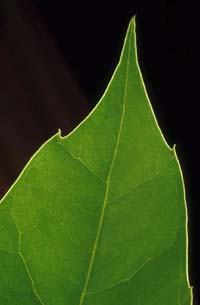
Required Readings
Science in Action 7
pages 104 - 107
or
Science Focus 7
pages 110 - 111
|
Diffusion at Work
Earlier in the lesson, we learned that diffusion works when there is a difference in concentration.
The carbon dioxide is at a higher concentration outside of the leaf than inside it so the molecules of carbon dioxide move through the stomata and into the cells of the leaf.
Since the carbon dioxide molecules are always being used up in the food making process, the carbon dioxide gas is always diffusing into the leaves.
Oxygen is diffusing out of the leaves because its concentration is higher inside the leaf. Oxygen is actually a waste product of photosynthesis.
|
|
| Leaves are the food factories of the plant. The colour green is the clue to look for. A green chemical called chlorophyll is used in the food making process. This process is called photosynthesis. Leaf size is determined by the amount of light the plant gets. For example, plants in deep forest shade tend to have large broad leaves, while those out in the sun tend to be small or thin. Examine the cross section of the leaf on page 111 in Science Focus, notice that there are air spaces between the cells of the leaf. To understand why this is necessary we must first understand the process of photosynthesis. We will use a word equation to understand the process. |
| The stem on a dandelion and the trunk of a tree perform the same job.
Plants in a forest setting are sometimes in competition for the sun's light. Those plants that can grow the fastest and highest will capture more of the sun's energy than those below them.
The stem, of trunk, is the portion of the plant that lifts the rest of the plant skyward.
Inside each stem or trunk there is a network of vessels that transports water and food throughout the plant.
|
|
|
Photosynthesis
is the name of the process that plants use to make food.
|
Wouldn't it be wonderful when we were hungry if we could just go outside and lay in the sun? Animals can't get their energy directly from the sun, but plants can. Plants make the food they need by a process called photosynthesis.
Have you ever wondered why plant leaves are green? Its because they have a special chemical in them called chlorophyll. Carbon dioxide, a gas, is part of our atmosphere. It enters the leaf through a stoma and travels through the air spaces to reach each cell that produces food. The water is transported up from the roots and moves through the veins in the leaf to the plant cells. When sunlight passes through the leaf the chlorophyll captures some of it and, along with the water and the carbon dioxide it is converted into food.

Scientists have developed shorthand ways of writing and what you see above is called a word equation. You should be able to write out the word equation for photosynthesis.
Transportation in Plants
So far in our learning adventure, we have found out how water, carbon dioxide and oxygen move around, but how does the plant get the food it makes to every cell in it body? Diffusion and osmosis are activities that occur naturally and normally in nature. The plant doesn't need to use up any energy in these processes. But moving food is a different story. The plant makes a food molecule called glucose. Glucose is a sugar molecule and is too big to get through the cell membrane and into the plant's cells. The plant must use a process called active transport to get the glucose into the cells, and that takes energy. Plants must use up some of its energy to move the food around to all the parts like the stem or root or flowers.
Cellular Respiration - Putting the Food to Work
So far, we have discovered that only plants can make their own food. But the next process is common to all living things - including you, me, whales, birds, grass, trees and bacteria. This common process to all living things is called cellular respiration.
By now, in our studies in grade 7 science, we know the plants can make their own food, and that even though animals can't make their own food, they can capture and kill other organisms to get the food they need. So what do all these living organisms do with this food? It is sent to every cell in their body and converted back into energy. This process is called cellular respiration. Look at the word formula for cellular respiration below. Is it different from the photosynthesis formula? Are there any similarities?

The formulas are opposites of each other! The whole wonderful world of living things cycles water, carbon dioxide and oxygen around and around between plants and animals. That is why we are constantly talking about the need for balance in the living world around us.
So, what have we learned?
1. Only green plants can make their own food through a process called photosynthesis.
2. The green part of the plant has a chemical called chlorophyll and it puts together the carbon dioxide, water and the sun's energy to make food.
3. All organisms, including plants and animals, use food for energy in a process called cellular respiration.
4. These processes take place at the cellular level.
5. The plant does not use up any energy in the processes of diffusion and osmosis.
6. Food molecules are too big to move by diffusion so the plant must use what is called active transport to move the food around its body, and this uses up some of the plants energy. |
|



